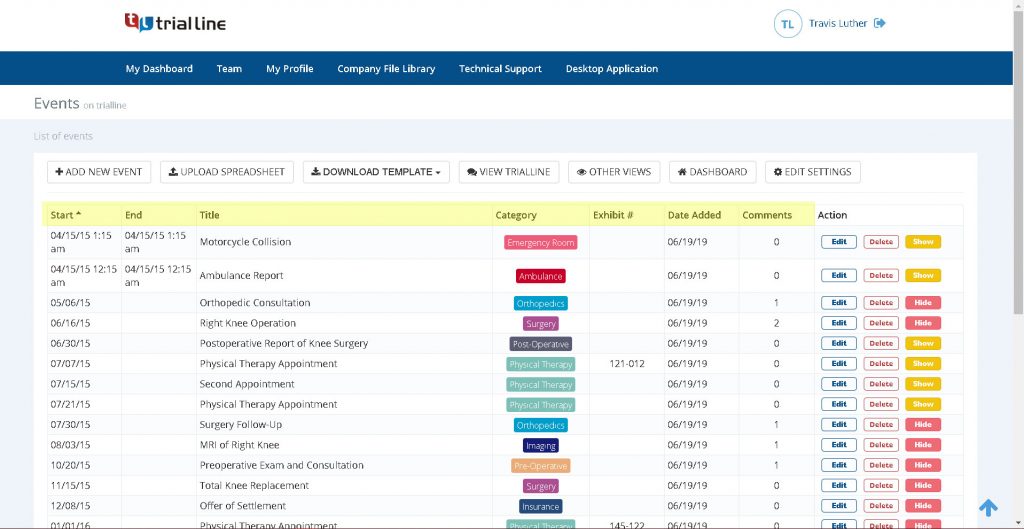Divorce is a period of change and uncertainty. Whether you’re certain about divorce or just exploring your options, it’s important to seek clarity. Understanding the timeline of divorce can help you manage this major life transition.
So, how long does the divorce process take? Although there’s no universal answer, divorce typically ranges from a few months to a year. The duration can be influenced by factors like state-specific laws, the ability to reach agreements, and whether children are involved.
As we examine the factors that may affect your divorce, we’ll also explore how legal timeline software can help set realistic expectations and guide you through the process.
Factors That Influence the Divorce Timeline

Several factors can affect the divorce timeline. Each divorce has its unique circumstances and complexities that shape the process.
Type of divorce
The divorce timeline depends on how quickly you and your spouse can reach an agreement, the time spent in mediation and negotiations, and whether the case goes to trial. Contested divorces may involve prolonged negotiations as both parties work toward a compromise. In an uncontested divorce, both parties agree on terms, often eliminating the need for mediation.
The state where you live
Each state has its divorce laws, many of which can extend the divorce process.
Residency requirements
Many states mandate a certain period of residence before you can file for divorce. In California, you must meet residency requirements for both the state and the county. In New York, you or your spouse must have lived in the state for at least a year before filing for divorce. A family lawyer can provide you most up-to-date guidelines.
Periods of separation
In some states, you cannot file for divorce until you have been separated for a certain period ranging from six months to a year. The required separation time can vary based on whether you have children and may include specific living arrangements. Consult a family lawyer to learn about your state’s regulations and how to fulfill the separation requirements.
Mandatory “cooling-off” periods
A “cooling-off” period refers to the required waiting time before a divorce can be finalized. These mandatory waiting periods allow couples to reconsider their decision or to adapt to their new circumstances. The duration of this period varies by state and may depend on whether the couple has children.
Case complexity
If your case involves significant assets or complex child custody or child support issues, the divorce process will likely take longer than usual.
For instance, if there is a dispute over an asset like a retirement account or real estate, a financial expert may be needed to assess its value, which can extend the duration of your case.
Additionally, if domestic violence is a factor in your divorce, the timeline may be further prolonged due to the need for additional hearings to fully address the situation and the severity of the abuse.
Court availability
The more crowded the court’s schedule, the longer your divorce process may take, as your case must wait its turn before being reviewed by a judge.
In some courts, cases can be restored within 30 days, while in others, your first court date might not be scheduled for six months. If your family or matrimonial court system is dealing with a backlog of cases, this will further extend the duration of your divorce. In countries with large populations, likely, many cases are ahead of yours, adding more time to the process.
Prenuptial and postnuptial agreements
A carefully drafted and legally enforceable post-nuptial or prenuptial agreement can minimize disputes over asset division, leading to faster settlements. Prenuptial agreements also involve full financial disclosure, which helps reduce the time spent gathering records and information.
Challenges in serving legal documents
One of the initial steps in the divorce process is serving your spouse with the divorce papers. If your spouse avoids receiving these papers, the divorce process will be delayed.
Special state requirements
Some states and countries have specific rules that can impact the duration of divorce proceedings. For instance, in Arizona and Florida, parents are required to attend a parenting class if the divorce involves children. In other states, such as Indiana, the case will only be scheduled in the court docket after the couple has completed mediation.
The Framework of a Divorce Process

While various factors and the duration of divorce can impact the timeline, here’s a general overview of how long the divorce process may take.
Remember that divorce is often a last resort and not an easy decision. Couples may have sought counseling or therapy before moving forward with the divorce.
Once the legal grounds are met, the planning for divorce can commence.
-
Services of process
The order of events in a divorce case begins with serving your spouse with divorce papers. There are three main methods to do this.
- Through a sheriff
- Through a special process server
- By having your spouse sign an acknowledgment of service to confirm receipt of the papers
If served by a sheriff or special process server, your spouse has 30 days to respond. A special process server typically charges between $100 and $150, and you can choose a specific time and place for service. Serving papers through a sheriff usually costs around $50, but the sheriff will service them at their own pace, which may take a week longer. Aside from the expense of preparing the document, there is no cost acknowledgment of service.
2. Discovery Phase
Once the divorce papers have been served, the discovery phase begins. This is the formal stage for gathering information. Typically, discovery lasts around six months, but it can extend longer and may take as little as 30 days.
Discovery involves requests for documents between spouses and subpoenas to banks and employers. Both you and your spouse may need to answer questions under oath, and witnesses might be called. Since discovery can be costly, it’s important to consult with a qualified divorce attorney to determine which aspects are necessary for your case.
3. Alternative Options for Dispute Resolution
After the discovery phase, spouses have several alternative dispute resolution options available to avoid going to court. They can exchange settlement proposals and try to reach an agreement through negotiations. If this doesn’t work, they may attend mediation to resolve their divorce. Mediation is highly cost-effective compared to litigation and offers a valuable opportunity to address any contentious issues.
4. Trial Litigation
If alternative dispute resolution options fail, your case will proceed to trial. Litigation involves presenting your case before a judge or jury, with formal testimonies from spouses, experts, and witnesses. Relevant documents and evidence may also be introduced to address financial or custody issues. Be aware that divorce trials can be both costly and emotionally draining.
5. End of the Divorce Process
A divorce case generally takes about six months, but the duration varies based on the process. Cases that settle in mediation are usually quicker than those that go to trial. Cases with extended discovery phases last longer than those with simpler issues.
The type of divorce can also influence the overall timeline, as certain types may involve additional stages.
| Type of Divorce | Factors That May Affect the Timeline | Average Duration |
| Uncontested Divorce | Issues with papers | Typically wrapped up in as quick as six weeks to three months |
| Contested Divorce | Agreement issues such as spousal support or division of assets, court trial | Depending on the state, it may take an average of six months to more than a year |
| Collaborative Divorce | Finding common ground on contentious issues | Should take less than a year |
| At-fault divorce | The reason for the divorce petition, grounds for the divorce, trial or hearing | An average time of at least a year |
| No-fault divorce | None, unless contested | May take less than three months |
Using Legal Timeline Software in the Divorce Process

Navigating through a divorce process is tough. However, with the right tools, legal support, and personal effort, you can organize, track, and manage the stages and tasks involved. Here’s how:
Visualizing the process
Divorce timeline software provides a clear, visual timeline of the entire divorce process, from filing to final judgment. This helps both parties understand the sequence of events and anticipate upcoming steps.
Tracking deadlines
Tracking important deadlines like filing dates, court appearances, and response deadlines is crucial in the divorce process. Timeline software for divorce attorneys helps ensure that you don’t miss any deadlines, avoiding potential delays and legal complications.
Organizing documents
Legal timeline software often allows for the uploading and organizing of essential documents. This ensures that both parties and their legal teams have easy access to relevant information at all times.
Managing discovery
During the discovery phase, the divorce case management software can help track documents, requests, subpoenas, and the responses received. It ensures that all necessary information is gathered efficiently.
Mediation and negotiation planning
A timeline software can help plan and track the progress of mediation sessions, negotiations, and settlement proposals, allowing both parties to see where they stand and what still needs to be resolved.
Coordinating with legal teams
The case timeline software can facilitate communication and coordination between the involved parties and their legal teams, ensuring everyone is on the same page and that no details are overlooked.
Preparing for trial
If the case goes to trial, the divorce lawyer software can help organize the presentation of evidence, witness testimonies, and other critical elements in a structured timeline, making it easier to prepare a solid case.
Divorce Case Management with a Legal Timeline Software

Navigating a divorce is challenging, so it’s essential to take the time to research and educate yourself before starting the process. The emotional toll can be exhausting, so being organized will empower you to begin your divorce from a position of strength. Seek professional help to manage emotions, and create a budget to understand your financial needs during the process. Complete a Domestic Relations Financial Affidavit which itemizes your expenses and assets to help you prepare. Additionally, be sure to hire an attorney who is the right fit for you.
As a legal professional involved in a divorce case, it’s crucial to document and manage every aspect effectively. Utilizing tools like TrialLine, a legal timeline software, can help streamline the process. TrialLine allows you to map out all of the events in the divorce process, attaching documents and evidence to each event for better organization. You can also add relevant individuals to the timeline to oversee specific events and collaborate effectively. To learn more about how TrialLine can assist in case management, sign up for our 7-day free trial and schedule a demo with one of our experts.







